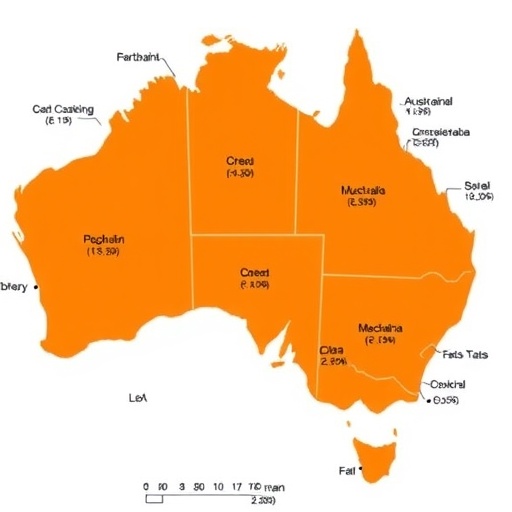In a pivotal advancement within the field of nutrition and refugee studies, a recent investigation published in the Journal of Nutrition Education and Behavior sheds critical light on the challenges faced by refugees resettling in Australia concerning food security. Despite the high prevalence of food insecurity among this vulnerable population, the study revealed a paradox wherein the very informational resources designed to aid refugees are largely inaccessible due to their complex language and lack of cultural relevance. This comprehensive analysis underscores a significant gap between the availability of nutritional support materials and their practical utility for refugees navigating a radically new food environment.
The study meticulously evaluated 184 distinct informational materials developed by government and community organizations aimed at supporting refugees in accessing and understanding food and nutrition within Australia. Through rigorous application of established evaluation metrics, including the Suitability Assessment of Materials (SAM), the Simple Measure of Gobbledygook (SMOG) readability test, and the American Library Association’s CRAAP criteria, the researchers thoroughly examined the accuracy, readability, cultural appropriateness, and relevance of these resources. The findings illustrate a stark imbalance: while the factual basis of the materials was sound, their linguistic complexity far exceeded recommended reading levels, rendering them largely ineffective for the intended audiences.
Of particular concern, 96% of the assessed materials were written beyond the optimal readability threshold to effectively communicate with refugees, many of whom may have limited proficiency in English or varying levels of literacy. This level of linguistic difficulty not only impedes comprehension but also potentially exacerbates food insecurity by hindering refugees’ ability to utilize available support systems. The issue is further compounded by a narrow range of topics addressed, with many resources failing to incorporate cultural and linguistic diversity adequately, thereby limiting their relevance and practical impact for a demographically heterogeneous refugee population.
The study’s lead author, Julie M. Wood, a graduate researcher specializing in human nutrition at Deakin University’s Institute for Physical Activity and Nutrition, emphasized the complex interplay between pre-existing food skills refugees bring with them and the demands of adapting to Australia’s distinct foodscape. Wood highlighted the necessity for informational materials that bridge this gap, enabling refugees to identify, procure, and prepare food in ways that honor cultural familiarity while adjusting to local availability. This nuance is essential for promoting both nutritional well-being and the psychosocial benefits of cultural continuity through food.
Furthermore, Wood and her colleagues argue that the persistent underutilization of plain language and failure to culturally tailor these materials reflect broader systemic deficits in public health communication strategies targeted at refugee populations. These deficits underscore an urgent need for multidisciplinary collaboration involving government bodies, non-governmental organizations, settlement service providers, and refugee community representatives. Such a coalition can facilitate the co-creation of more accessible, linguistically inclusive, and culturally sensitive resources that resonate with refugees’ lived experiences.
The study advances the discourse around food security by linking the immediacy of access to comprehensible information with long-term nutritional resilience and integration outcomes for refugees. It also sets a precedent for refining public health materials through integrating readability tools like SMOG and SAM into routine evaluations. This approach ensures that content not only is factually accurate but also tailored to the cognitive and cultural realities of marginalized populations. Additionally, employing the CRAAP framework solidifies a critical dimension by assessing the currency and authority of nutritional guidance, which is paramount in an evolving food and health policy landscape.
In addressing these challenges, recommendations from the research emphasize the imperative of adopting plain language principles, which promote clarity and simplicity without sacrificing technical precision. Texts composed with this philosophy are more likely to engage and inform readers with diverse literacy levels, thereby enhancing their capacity to make informed food choices. Equally important is the acknowledgment of cultural foodways that shape dietary practices, which calls for materials that not only translate language but also contextualize nutritional concepts within familiar culinary traditions.
Moreover, visual engagement emerges as a crucial element of effective communication. The study suggests that incorporating culturally relevant imagery and intuitive design features not only supports textual understanding but also fosters emotional connection and empowerment. Such multimodal approaches align with contemporary findings in health literacy research, which identify visual aids as catalysts for improved comprehension and behavioral uptake among low-literacy and culturally diverse groups.
This research also resonates within the broader public health policy domain, asserting that food security interventions for refugees must transcend mere provision of aid to encompass education informed by socio-cultural sensitivity and participatory methodologies. By engendering a more inclusive framework, policymakers can contribute to reducing health disparities and promoting equitable access to nutritious food, thereby supporting refugees’ holistic well-being and societal integration.
Importantly, the study’s reliance on a comprehensive evaluative methodology not only validates its findings but also offers a replicable model for assessing similar resources globally. As refugee populations continue to grow and diversify worldwide, the implications of this research extend beyond Australia, highlighting a universal need to scrutinize and optimize health communication strategies for displaced communities.
In closing, this pioneering study effectuates a call to action for researchers, practitioners, and policymakers invested in refugee health and nutrition. It advocates for transcending traditional paradigms by fostering partnerships and innovation in resource development that respect linguistic diversity, uphold readability standards, and reflect cultural legitimacy. These steps are essential to transforming accurate but inaccessible food security information into practical tools that genuinely empower refugees and nurture their journey toward food sovereignty in resettlement contexts.
Subject of Research: Not applicable
Article Title: The Suitability, Readability, and Accuracy of Food Security Resources for Refugees Resettling in Australia
News Publication Date: November 5, 2025
Web References: https://doi.org/10.1016/j.jneb.2025.06.005, https://www.jneb.org/
References: Journal of Nutrition Education and Behavior
Image Credits: Journal of Nutrition Education and Behavior
Keywords: Food Security, Refugees, Readability, Nutrition Education, Public Health Communication, Cultural Sensitivity, Australia, Health Literacy, Resource Evaluation, Food Access, Multicultural Nutrition, Plain Language




